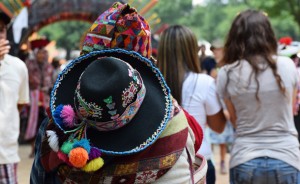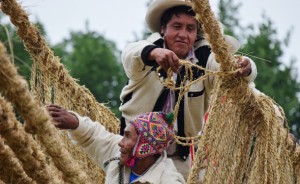Eastern Mennonite University senior Victoria Gunawan, a native of Indonesia, spent her summer among Peruvians on the National Mall in Washington D.C. As a media intern at the Smithsonian Folklife Festival, she recorded the painstaking creation of a replica of the famous “Q’eswachaka” swinging bridge by Peruvian craftsman, and was honored to be among the select few to cross its woven path.
She also fell in love with alpacas, videoed the Blessing of the Festival, learned a bit of the endangered Kukama language, and helped orient visitors to the variety of goings-on during the two-week festival.
Now back in Harrisonburg, Gunawan says her summer living at the Washington Community Scholars’ Center (WCSC) and working for the famous Smithsonian Institution is still a bit of a blur: Though her peers and professors told her many times about what a privilege her summer job was, “even now, I’m still trying to process that ‘woohoo’ moment, like, ‘Hey I was at the festival, and I did work at that prestigious place.’ I still can’t believe it,” Gunawan said.
‘Career-launching’ internships
Gunawan, a visual and communication arts major, takes moving to a new place and meeting new people in stride. She first came to the United States to study at Hesston College, and eventually fell in love with the EMU campus, transferring for her junior year.

“[The student that inspired me to attend EMU] left after my first spring semester, but she helped me to transition here,” Gunawan said, adding that the pair are still friends today.
Gunawan began thinking about her summer plans in January with the help of WCSC director Kimberly Schmidt. After years of living in the D.C. area and networking on behalf of EMU students, Schmidt has contacts in the Smithsonian Institutes, including the Folklife Center, which hosts the annual festival on the Mall, the National Museum of the American Indian, the Anacostia Community Museum and the Latino Center.
She’s always excited when a student lands a prestigious internship at these important cultural institutions.
“I hope that as word gets out, more EMU students will apply to these internships. We’ve had great success partnering with the Smithsonian. These are career-launching internships and though the application process is highly competitive, the Smithsonian is interested in working with our students.”
Gunawan did indeed survive a competitive interview process. Though experienced in different aspects of public relations and marketing through internships with the university’s marketing and communications department, she had no idea of what the next nine weeks would hold in store.
“Even though my supervisor told me to get familiar with the [Folklife Festival] website, and I was, I still wasn’t sure of what was happening where and when,” Gunawan said. “For me, every day was a completely new day.”
Reporting on the ground
Her work started before the festival began. Gunawan posted daily “little glimpses” on Twitter and Facebook of what visitors would see in a few weeks.

When festivities actually started on June 24, events kept Gunawan busy.
“Every day, my supervisor and I would look at the schedule and see what was happening, and we would try to cover those events, either by taking pictures, or small Instagram 15-second videos or Vine six-second videos, or even just by getting a quote from one of the participants,” Gunawan said.
The internship did not come without challenges: some Peruvians communicated only through a Spanish translator, and there were many indigenous people who did not speak Spanish.
Despite the challenges, Gunawan did not forget to enjoy herself while she was there. Over two Fridays, alpacas were brought in for a ritual performed by the weavers from the Chinchero community in Peru.
The alpacas “warmed my heart,” Gunawan said. “One of the communities in Peru has a traditional fiber blessing ceremony for when the alpacas give birth. They have a whole ritual of praying to the Pachamama, or Mother Earth, their Apu, or mountain spirit, their ancestors, and natural forces for safety on their land. They sprinkle the alpacas with this drink called chicha, which is fermented corn alcohol, while saying the blessing.”
Crossing the bridge
Although alpacas were Gunawan’s personal favorite, the Q’eswachaka bridge was monumentally impressive, she said, the big “icon they were going for.”
“Four communities in Peru re-build a bridge every year between these two really high cliffs. It’s a 600-year tradition,” Gunawan said. The same crew that rebuilds the bridge spanning the Apurimac River near Huinchiri each June hustled to finish their project at home so that they could travel to the United States to build a smaller replica.

Gunawan was in charge of documenting the bridge building for social media, catching every moment from casting the first rope to tying the last knot. Although the public was not able to walk on the bridge, event staff had the privilege to cross if they choose, and Gunawan — most likely the first and last Indonesian to cross the Q’eswachaka Bridge, she says — was excited about the opportunity.
Her only regret was her inability to cover every event. This was both an outcome of the small size of the social media unit (consisting of Gunawan and her supervisor exclusively), and the numerous events taking place day to day.
“Through the work of other [interns], I got to see what was happening in other places,” Gunawan said.
As she prepares for her final year at EMU, Gunawan says she’ll carry her memories of this summer, along with hopes of one day returning to work at future Folklife Festivals.
